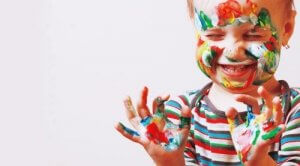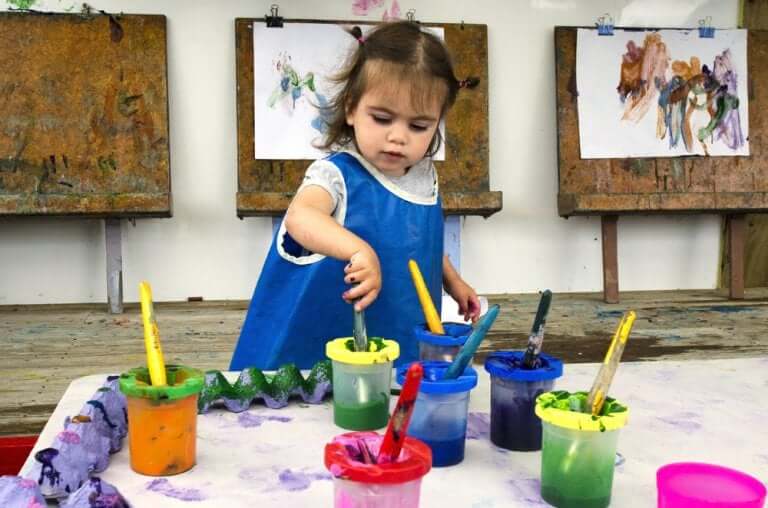How to Encourage Artistic Talent in Preschool Children


Written and verified by the teacher Azucena Fernández
If we think about art for preschoolers, we’ll know that drawing is one of the first ways they learn to express their creativity. Drawing helps children in their emotional, cognitive, and social development. It’s also a way for them to communicate. Believe it or not, it is possible to nurture your child’s artistic talent in preschool.
Spontaneous drawing in preschool makes it possible for children to express ideas about the things that surround them, and about other people. We should, therefore, encourage them to develop this talent.
Let’s see some tips about how to nurture your child’s artistic talents in preschool.
Nurturing your child’s artistic talent in preschool
If you want them to do it, do it yourself
Remember that parents are children’s first role models, and their best examples to follow. So, if we want our children to develop their artistic talent, starting with drawing, then we as parents have to be the first to pick up our brush (or pencil).

It’s important to communicate with your children, so that they’ll understand what you’re doing when they see you doing it. Very soon they’ll try to imitate you.
It’s important to work on the good things that we’re capable of doing. We should never say that our, or another person’s, artwork isn’t very good. Promote the positive aspects of what we draw and what our children draw.
If children see that we’re confident about what we’re doing, then they’ll also feel confident. It’s not about us being artists, it’s just about arousing the children’s interest and encouraging them to express themselves through art.
Explore techniques to nurture your child’s artistic talent
When we’ve established our routine of painting, coloring, and drawing, then we’ll want to try to find new techniques.
We should always look for new ideas so that we’re not always doing the same thing. We shouldn’t limit ourselves to painting with tempera, pencils or crayons. Other items such as chalk, pens, or even finger paint can be great.
We need to give our children the option of choosing, and making their own discoveries. Giving them space to freely create whatever they want will be the ideal way to nurture your child’s artistic talent in preschool.
Talk to your child
One sure way for a child to feel encouraged about drawing is to show an interest in what they draw. We can encourage them to improve, but it’s enough to simply say things like “how nice” in response to their artwork. It’s good to talk about all the details on their drawings or paintings, the colors, and to suggest other things they could draw.
Sitting still and drawing on a piece of paper may not always seem like fun to our child. Because of this, we should be looking to always suggest new ideas for them to do. The best thing to do is to find out what they’re interested in and what they like doing. Simply ask and listen. Communication is essential.

Keep in mind their age
It’s essential that, as parents, we know what sort of painting and drawing each child is capable of doing according to their age. There are clearly distinct phases in children’s artistic development:
- First, when they’re very young, they’ll start by scribbling
- Then, little by little, they’ll evolve and start to draw and paint more realistic things.
- Around the age of three they’ll be able to start joining lines.
- Between the ages of three and four, they’ll try to create realistic images. This is a natural progression and it’s important for parents to be aware.
Be patient
If the children are young, then their attention span will be very limited. So, be patient with them, and don’t pressure them into painting or coloring. It’s preferable to give them blank paper and let them do whatever they want than to buy them a coloring book.
If they don’t feel like drawing it doesn’t matter, we can leave it for another day when they’ll feel like it. The desire to paint or draw must come from the child.
Finally, remember that artistic talent doesn’t mean brilliance or perfection. The important thing is that they enjoy it, that they have fun, and that it develops their creativity.
If we think about art for preschoolers, we’ll know that drawing is one of the first ways they learn to express their creativity. Drawing helps children in their emotional, cognitive, and social development. It’s also a way for them to communicate. Believe it or not, it is possible to nurture your child’s artistic talent in preschool.
Spontaneous drawing in preschool makes it possible for children to express ideas about the things that surround them, and about other people. We should, therefore, encourage them to develop this talent.
Let’s see some tips about how to nurture your child’s artistic talents in preschool.
Nurturing your child’s artistic talent in preschool
If you want them to do it, do it yourself
Remember that parents are children’s first role models, and their best examples to follow. So, if we want our children to develop their artistic talent, starting with drawing, then we as parents have to be the first to pick up our brush (or pencil).

It’s important to communicate with your children, so that they’ll understand what you’re doing when they see you doing it. Very soon they’ll try to imitate you.
It’s important to work on the good things that we’re capable of doing. We should never say that our, or another person’s, artwork isn’t very good. Promote the positive aspects of what we draw and what our children draw.
If children see that we’re confident about what we’re doing, then they’ll also feel confident. It’s not about us being artists, it’s just about arousing the children’s interest and encouraging them to express themselves through art.
Explore techniques to nurture your child’s artistic talent
When we’ve established our routine of painting, coloring, and drawing, then we’ll want to try to find new techniques.
We should always look for new ideas so that we’re not always doing the same thing. We shouldn’t limit ourselves to painting with tempera, pencils or crayons. Other items such as chalk, pens, or even finger paint can be great.
We need to give our children the option of choosing, and making their own discoveries. Giving them space to freely create whatever they want will be the ideal way to nurture your child’s artistic talent in preschool.
Talk to your child
One sure way for a child to feel encouraged about drawing is to show an interest in what they draw. We can encourage them to improve, but it’s enough to simply say things like “how nice” in response to their artwork. It’s good to talk about all the details on their drawings or paintings, the colors, and to suggest other things they could draw.
Sitting still and drawing on a piece of paper may not always seem like fun to our child. Because of this, we should be looking to always suggest new ideas for them to do. The best thing to do is to find out what they’re interested in and what they like doing. Simply ask and listen. Communication is essential.

Keep in mind their age
It’s essential that, as parents, we know what sort of painting and drawing each child is capable of doing according to their age. There are clearly distinct phases in children’s artistic development:
- First, when they’re very young, they’ll start by scribbling
- Then, little by little, they’ll evolve and start to draw and paint more realistic things.
- Around the age of three they’ll be able to start joining lines.
- Between the ages of three and four, they’ll try to create realistic images. This is a natural progression and it’s important for parents to be aware.
Be patient
If the children are young, then their attention span will be very limited. So, be patient with them, and don’t pressure them into painting or coloring. It’s preferable to give them blank paper and let them do whatever they want than to buy them a coloring book.
If they don’t feel like drawing it doesn’t matter, we can leave it for another day when they’ll feel like it. The desire to paint or draw must come from the child.
Finally, remember that artistic talent doesn’t mean brilliance or perfection. The important thing is that they enjoy it, that they have fun, and that it develops their creativity.
All cited sources were thoroughly reviewed by our team to ensure their quality, reliability, currency, and validity. The bibliography of this article was considered reliable and of academic or scientific accuracy.
- Karnes, Merle B., y Angela R. Taylor. Preschool Talent Assessment Guide. (1978).
- Jin, Suk-un, y John F. Feldhusen. Parent identification of the talents of gifted students. Gifted Education International. (2000).
This text is provided for informational purposes only and does not replace consultation with a professional. If in doubt, consult your specialist.








